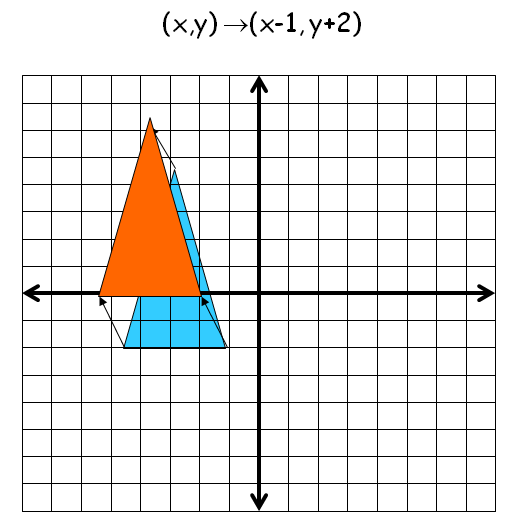TRANSLATION TRANSFORMATION IN GEOMETRY
Translation transformation is one of the four types of transformations in geometry.
Translation - Definition
A translation slides an object a fixed distance in a given direction. The original object and its translation have the same shape and size, and they face in the same direction. It is a direct isometry.
In simple words, translation means, it just moves the given figure without rotating, re sizing or anything else.
Translation - Rule
Translation of (h, k) :
(x, y) -----> (x + h, y + k)
Translation for (h, k) = (-1, 2)

Once students understand the above mentioned rule which they have to apply for translation transformation, they can easily make translation-transformation of a figure.
For example, if we are going to make translation transformation of the point (5, 3) for (h, k) = (1, 2), after transformation, the point would be (6, 5).
Here, the rule we have applied is
(x, y) -------> (x + h, y + k)
So, we get
(5, 3) -------> (6, 5)
Let us consider the following example to have better understanding of translation.
Question :
Let A(-2, 1), B(2, 4) and C(4, 2) be the three vertices of a triangle. If this triangle is translated for (h, k ) = (2, 3) what will be the new vertices A', B' and C' ?
Solution :
Step 1 :
First we have to know the correct rule that we have to apply in this problem.
Step 2 :
Here, triangle is translated for
(h , k ) = (2 , 3)
So, the rule that we have to apply here is
(x, y) -------> (x + h, y + k)
Step 3 :
Based on the rule given in step 1, we have to find the vertices of the translated triangle A'B'C'.
Step 4 :
(x, y) -----> (x + h, y + k)
A(-2, 1) -------> A'(0, 4)
B(2, 4) -------> B'(4, 7)
C(4, 2) -------> C'(6, 5)
Step 5 :
Vertices of the translated triangle are
A'(0, 4), B(4, 7) and C'(6, 5)
How to sketch the translated figure?
1. First we have to plot the vertices of the pre-image.
2. In the above problem, the vertices of the pre-image are
A(-2, 1), B(2, 4) and C(4, 2)
3. When we plot these points on a graph paper, we will get the figure of the pre-image (original figure).
4. When we translate the given figure for (h, k) = (2, 3), we have to apply the formula
(x, y) -------> (x + h, y + k)
5. When we apply the formula, we will get the following vertices of the image (translated figure).
6. In the above problem, vertices of the image are
A'(0, 4), B'(4, 7) and C'(6, 5)
7. When plot these points on the graph paper, we will get the figure of the image (translated figure).
Kindly mail your feedback to v4formath@gmail.com
We always appreciate your feedback.
©All rights reserved. onlinemath4all.com
Recent Articles
-
Logarithmic Derivative Problems and Solutions
Apr 16, 25 09:25 PM
Logarithmic Derivative Problems and Solutions -
Digital SAT Math Problems and Solutions (Part - 145)
Apr 16, 25 12:35 PM
Digital SAT Math Problems and Solutions (Part - 145) -
Digital SAT Math Problems and Solutions (Part - 144)
Apr 14, 25 07:27 PM
Digital SAT Math Problems and Solutions (Part - 144)

